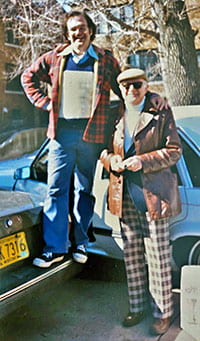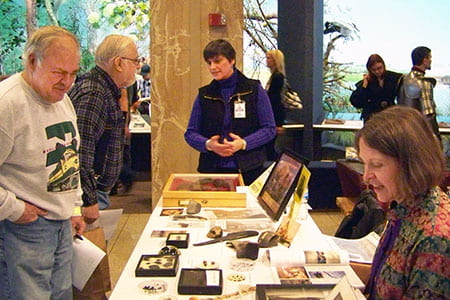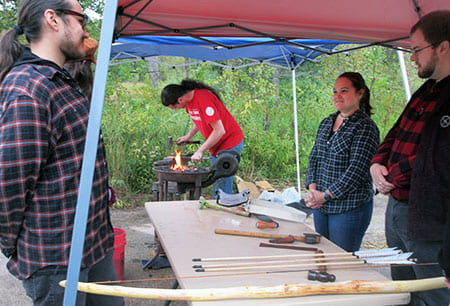By Alice Kehoe, Jane Waldbaum and Bettina Arnold
The Milwaukee Society was founded more than 50 years ago in 1968. We began as a gleam in the eye of Dr. Stephan F. Borhegyi, an energetic Mayan archaeologist who was Director of Milwaukee Public Museum during the 1960s. With assistance from the Friends of the Museum, itself organized not long earlier, Borhegyi pitched the value of affiliation with AIA to Friends who had expressed interest in archaeology, and to area professionals. Moving Milwaukee Public Museum from its quarters in Central Public Library to its Wells Street building occupied much of Borhegyi’s time in 1964 and 1965. Once settled, he contacted Dr.
Emmett L. Bennett, Jr, of UW-Madison about reconstituting a Wisconsin Society of the AIA, one of the first affiliates (1889) of the AIA after its founding in 1879. Dr. Bennett proposed Milwaukee become a branch of the already existing Madison chapter, but secondary status was never Borhegyi’s preference. By 1967, Borhegyi had recruited nearly double the minimum 25 members to start an AIA chapter, officially known as the Milwaukee Society. The national AIA granted us official Society status at its December 1967 Annual Meeting. Tragically, Borhegyi died in an automobile accident on I-43 downtown in September, 1969.
 Our first president was Mrs. Thomas F. Fifield, a civic-minded River Hills resident, who remained a member until her death in 2003. Vice-Presidents were two academics, art patron Dr. John Pick, a professor in Marquette’s English Department, and Dr. Robert Ross of UWM’s Classics Department. Dr. Ross and his wife, Miriam Ross, carried out much of the business of the chapter into the 1970s. Dr. Sidney Goldstein of UWM’s Art History Department served as Society secretary in the early 1970s, until he left Wisconsin in 1973 to become Curator of Ancient Glass at the Corning Museum of Glass in upstate New York. Membership in the Milwaukee Society has always been a mix of professional archaeologists, students and avocational members—members of the community interested in learning about archaeology and interacting with professionals. Both academics and avocationals have been leaders of Milwaukee AIA. Among the former were Dr. Rudolph Dornemann, curator of Near and Middle Eastern archaeology at Milwaukee Public Museum in the 1970s, and his successor Carter Lupton, now Curator Emeritus, Ancient History. Among our early avocational leaders were Virginia Read, John Ebersol, Teresa Weber, and most outstandingly, the late George Morse. George Morse was a founding member, treasurer, publicity officer, president 1971-1973, and, by coincidence, and many years later, father-in-law of Jane Waldbaum.
Our first president was Mrs. Thomas F. Fifield, a civic-minded River Hills resident, who remained a member until her death in 2003. Vice-Presidents were two academics, art patron Dr. John Pick, a professor in Marquette’s English Department, and Dr. Robert Ross of UWM’s Classics Department. Dr. Ross and his wife, Miriam Ross, carried out much of the business of the chapter into the 1970s. Dr. Sidney Goldstein of UWM’s Art History Department served as Society secretary in the early 1970s, until he left Wisconsin in 1973 to become Curator of Ancient Glass at the Corning Museum of Glass in upstate New York. Membership in the Milwaukee Society has always been a mix of professional archaeologists, students and avocational members—members of the community interested in learning about archaeology and interacting with professionals. Both academics and avocationals have been leaders of Milwaukee AIA. Among the former were Dr. Rudolph Dornemann, curator of Near and Middle Eastern archaeology at Milwaukee Public Museum in the 1970s, and his successor Carter Lupton, now Curator Emeritus, Ancient History. Among our early avocational leaders were Virginia Read, John Ebersol, Teresa Weber, and most outstandingly, the late George Morse. George Morse was a founding member, treasurer, publicity officer, president 1971-1973, and, by coincidence, and many years later, father-in-law of Jane Waldbaum.
In recent years, AIA-Milwaukee has been led by academic archaeologists including Jane Waldbaum, professor emerita of Art History, UWM, who went on to become national AIA president (2003-2007), Bettina Arnold of the UWM Anthropology Department; Derek Counts, David Pacifico and the late Andrea Stone of UWM’s Department of Art History; Elisabetta Cova, from the Classics Program in UWM’s Department of Ancient and Modern Languages, Literatures, and Cultures (AMLLC); and Jane Peterson and Alice Kehoe (professor emeritus) Anthropology, Marquette. The varied interests and academic disciplines of our presidents, ranging from Germany to Jordan, Cyprus to Central America, reflect the broad interests of our membership and of the AIA lectures we host every year.
In the past, lectures were held at Milwaukee Public Museum, Concordia College, and Marquette as well as at UWM. Now UWM, in partnership with the Art History, Classics (AMLLC) and Anthropology departments, provides space in Sabin Hall for our lectures and receptions.
Back in 1967, AIA dues were $15 and included a subscription to Archaeology magazine. The National AIA office sent us $50 to start us off, and in our first year, 1968, we received $64.50 from them, including rebates based on the total number of members. Altogether, our income that year was $179.75, our expenses $140.80, and we have operated in the black ever since! Each year most of our operating budget comes from rebates on national membership dues, and sometimes on “luck of the draw” as we won the AIA’s local society lecture lottery for 2009-2010 resulting in a jackpot of over $800 for the year! We also happily receive donations from members to supplement this income or to cover special projects (gifts to AIA are tax-deductible). Our most delicious donation came in 2004 when we received a bequest from one of our faithful and enthusiastic members, the late Helen Bernstein, to cover expenses for refreshments for twenty years! Helen regularly brought carefully themed refreshments to our meetings—olives and pistachios for Middle East lectures, corn chips and chocolate for Maya—and among her last wishes was that her family create a fund to perpetuate her generosity. We sorely miss Helen’s insightful and stimulating questions after lectures, even as we enjoy her legacy at our informal receptions. Some other regulars who have passed away include Tula Erskine, George and Renata Morse, Gene Erasmus, Otto Heimler, Pat Wagner and Dorothy Zess. We miss them all.
In some years we’ve had field trips, most often to Chicago museums for special exhibits, such as Pompeii and Tut at the Field Museum in 2007, the Oriental Institute in 2008, the Aztec World at the Field Museum in 2009, a trip to the Field Museum in April 2016 to see the “Greeks from Agamemnon to Alexander” exhibition, and an April 2017 trip to Kenosha to see the Civil War Museum and Kenosha Public Museum with behind-the-scenes tours in both places and a nice lunch organized by Milwaukee Society member Dave Adam. More recently, when COVID-19 disrupted our ability to gather in person for lectures and field trips, we developed an information sheet on area archaeological sites that everyone can visit on their own.

Some more recent programs developed by The Milwaukee Society focused on engaging students and young people with some of the many aspects of archaeology. The Milwaukee Archaeology Fair co-sponsored by the Milwaukee Public Museum and the AIA-Milwaukee Society ran every March from 2010 to 2014, bringing together archaeologists, students, museum educators and teachers, children and members of the general public. It twice received an AIA Society Outreach Grant to help defray expenses. Though Milwaukee’s Archaeology Fair appeared for only five years, it inspired similar events that later took place at other AIA local societies.

International Archaeology Day (IAD) was begun by the national AIA in 2011 to bring the AIA together with other archaeological organizations, universities, museums and similar institutions that support or feature archaeology. These institutions present programs, at first around North America, and now around the world, to bring archaeology to many different audiences. The Milwaukee Society has celebrated IAD here in October most years since 2011 with themes such as “Life after Fieldwork: Behind the Scenes at UW-Milwaukee’s Archaeology Research Lab,” (2011); “The Archaeology of Food and Drink,” (2012); “Games Ancient People Played,”(2013); “You Are What You Wear: Clothing and Adornment in the Ancient World,” (2016); “Down Home Archaeology: Digging into the Past with Local Archaeologists,” (2017); and “War, Peace, and the Feast,” (2018). IAD is now celebrated in more than two dozen countries around the world with over 900 events hosted by over 600 sponsoring institutions.

Here in Milwaukee our main activity has always been our lectures, each year bringing archaeologists on lecture tours organized by the national office, and several additional archaeologists that we recruit ourselves. The COVID-19 pandemic of 2020-22 introduced us to the possibilities of virtual lectures, sponsored both nationally and locally and will now continue to be part of our mix of programs going forward. Members of the Milwaukee Society have contributed to the national organization as well. Jane Waldbaum served as national president from 2003-2007, Derek Counts and David Adam served as Trustees on the national Governing Board for two terms, and David Adam is in his first term as national Treasurer. Over the years we have produced several national lecturers including Andrea Stone, Derek Counts, Bettina Arnold, Jane Waldbaum, and Alice Kehoe; Bettina Arnold, Jane Waldbaum, and Derek Counts have served on many national AIA committees; from 2011 to 2016, Derek and Elisabetta Cova served as co-book review editors of the AIA’s scholarly journal the American Journal of Archaeology.
Our avocational and student members equally deserve recognition. 1995 saw the kick-off of our local newsletter The Artifact, with Al and Amy Sellers, then graduate students in Art History at UWM, as founding editors. Since then, Jocelyn Boor (Anthropology), Katherine Murrell (Art History), Ricky Kubicek (Anthropology), Sara Rich and Anna Connors (Art History), Josh Driscoll and Lydia McDermott (Anthropology) in turn have assumed the task of newsletter editor. Lydia McDermott was the editor in charge during our recent transition to an all-digital formal of The Artifact, now sent to all Milwaukee Society members by e-mail.
In the “olden days” the local secretary and helpers spent afternoons sorting mailings by zipcode; now, in the digital age, Homer Hruby created a handsome website for us (https://aia-milwaukee.uwm.edu/), and notices of our lectures and other events of interest to our members go out quickly via e-mail.
The AIA-Milwaukee Society remains healthy and vibrant. As always, our strength comes from our members. We welcome your participation and suggestions for improvement. We look forward to many more years of bringing the latest information about archaeology to our members and to the Milwaukee community through the AIA-Milwaukee Society.
